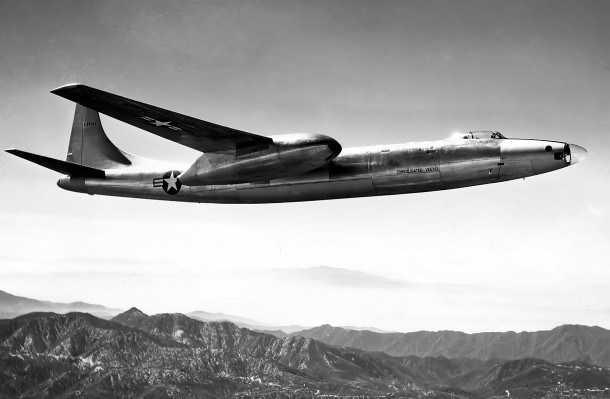
Seventy years ago this week, the USAF/Convair XB-46 took to the skies on its maiden flight. Convair test pilot Ellis D. “Sam” Shannon was at the controls of the sleek, multi-jet prototype medium range bomber.
The XB-46 was a product of the flurry of aircraft design-build-and-fly activity that gripped the American aviation industry in the second half of the 1940’s. While most never saw the production line, all manner of new and innovative aircraft design concepts were built and flown by aircraft companies.
The XB-46 was a contemporary of and competitor with other jet-powered bomber concepts such as the North American XB-45 Tornado, North American XB-47 Stratojet, and Martin XB-48. With an unrefueled range of 2,500 nm and a service ceiling of 40,000 feet, the XB-46 was designed to carry a bomb load of 22,000 lbs.
The big bomber measured 105.75 feet in length and had a wingspan of 113 feet. Power was provided by a quartet of J35 turbojets which delivered 16,000 lbs of sea level thrust. The type’s gross take-off and empty weights were 95,000 lbs and 48,000 lbs, respectively.
The XB-46’s air crew consisted of a pilot and co-pilot who sat in tandem as well as a third crew member who was situated in the nose. This latter individual was a real jack-of-all-trades who served as the bombardier, navigator, and radio operator.
The one and only XB-46 aircraft (S/N 45-59582) departed on its first flight from Convair’s Lindbergh Field in San Diego on Wednesday, 02 April 1947. Pilot Sam Shannon headed north to Muroc Army Air Field where he safely landed an hour and a half later following an uneventful flight.
By the end of September 1947, the lone XB-46 aircraft had made 64 flights and spent 127 hours in the air. While the aircraft was found to have excellent stability and control characteristics and favorable handling qualities, the rapid pace of aeronautical progress quickly rendered it obsolete.
Although the XB-46 project was cancelled in August 1947, the airplane was transferred to Florida’s Palm Beach Air Force Base for additional flight testing. Researchers focused primarily on airframe structural and vibrational issues during the 44 hours of flight testing that took place from August 1948 to August 1949.
Although a worthy design concept that flew well, the XB-46 was eclipsed by a better airplane. In this case, the legendary USAF/Boeing B-47 Stratojet. But such was the fate of many post-WWII aircraft projects that vied for military production contracts during the fifth and sixth decades of the twentieth century.
The XB-46 exhibited a certain majesty in flight that was emblematic of the early jet age. Its development helped to improve the art of designing and flying large aircraft. As such, it would be nice to see it displayed in a prominent aviation museum. Regrettably, the single XB-46 prototype airframe was scrapped in the early 1950’s and no longer exists.

